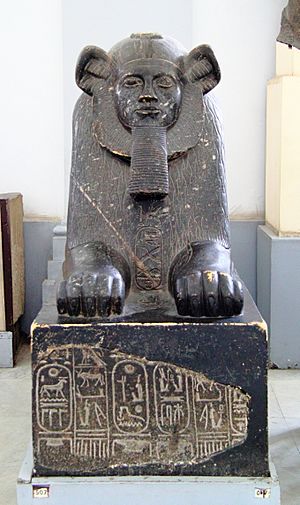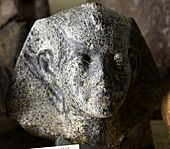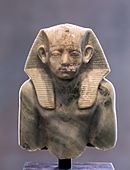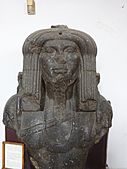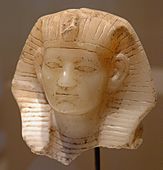Amenemhat III facts for kids
- See Amenemhat, for other individuals with this name.
Quick facts for kids Amenemhat III |
|
|---|---|
| Lamares, Lampares, Ameres, Ammenemes (according to Manetho) | |
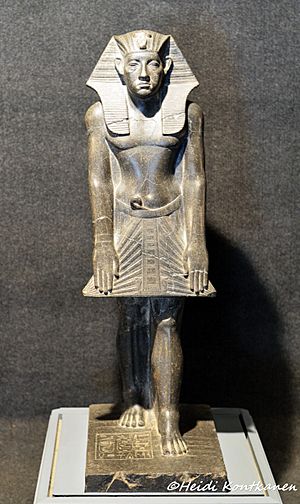
Statue of Amenemhat III, Luxor Museum
|
|
| Pharaoh | |
| Reign | 1860–1814 BC (12th Dynasty) |
| Predecessor | Senusret III |
| Successor | Amenemhat IV |
| Consort | Aat, Khenemetneferhedjet III |
| Children | Neferuptah, Sobekneferu, Hathorhotep, Sithathor, Amenemhat IV (?) |
| Father | Senusret III |
| Died | 1814 BC |
| Burial | Pyramid at Hawara |
| Monuments | Pyramids at Dahshur and Hawara |
Amenemhat III was a powerful pharaoh (king) of ancient Egypt. He ruled during the 12th Dynasty, from about 1860 BC to 1814 BC. Many historians believe his time was a "golden age" for the Middle Kingdom.
He might have ruled alongside his father, Senusret III, for about 20 years. This was called a coregency. Later, Amenemhat III also shared his rule with his own successor, Amenemhat IV. After Amenemhat IV, his daughter, Sobekneferu, became the last ruler of their dynasty.
Amenemhat III's special throne name was Nimaatre. This name meant "Belonging to the Justice of Re," connecting him to the sun god Ra.
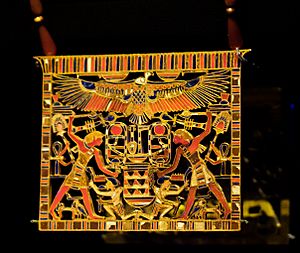
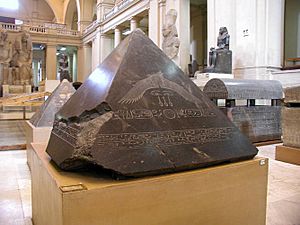
Contents
Building Amazing Pyramids
Amenemhat III built two large pyramids. His first pyramid was at a place called Dahshur. It was known as the "Black Pyramid" because of its dark stone. However, there were problems during its construction, so he stopped building it.
Around his 15th year as pharaoh, he decided to build a new pyramid. This one was at Hawara, near the Faiyum area. The Dahshur pyramid was still used as a burial place for some royal women.
The Labyrinth at Hawara
The mortuary temple next to the Hawara pyramid was very famous. Ancient Greek historians like Herodotus and Diodorus Siculus called it the "Labyrinth". Another writer, Strabo, even said it was one of the wonders of the world!
The Hawara pyramid had very clever security features. These were meant to protect the king's burial from robbers. Sadly, even with these features, the tomb was robbed long ago.
The pyramidion (the capstone) from Amenemhat III's Hawara pyramid was found. It had fallen from the top but was mostly in good shape. Today, you can see it in the Cairo Egyptian Museum.
Expeditions and Mining
Amenemhat III didn't lead many military battles. We only know of one small mission in his ninth year. This mission was in Nubia, near the fortress of Kumma.
However, he sent many expeditions to mining areas. These trips were important for getting valuable materials.
- Amethyst: Two trips went to Wadi el-Hudi to collect Amethyst. This beautiful purple stone was used for jewelry.
- Stone for Statues: Other trips went to Wadi Hammamat. They broke stone for statues and building projects. Some of these trips might have been for his pyramid at Hawara.
- Punt: An inscription found near the Red Sea mentions an expedition to Punt. Punt was a faraway land known for its exotic goods.
The Great Canal (Mer-Wer)
One of Amenemhat III's biggest achievements was a huge building project. He continued work that his father probably started. This project aimed to connect the Fayum Depression with the Nile River.
Before this, the Fayum area was mostly a swamp. A massive canal, about 16 kilometers (10 miles) long and 1.5 kilometers (1 mile) wide, was dug. It was called Mer-Wer, meaning "the Great Canal." Today, it is known as Bahr Yussef.
This amazing engineering project helped control the Nile's floodwaters. It created a large storage area called Lake Moeris. This lake could hold billions of cubic meters of water each year.
The canal brought great wealth to the Fayum region. It turned the area into a major source of food for Egypt. The canal was used for a very long time, bringing prosperity to the country.
Art and Statues
Amenemhat III is famous for the many statues made of him. About 80 statues or parts of statues have been found. His statues continued the style of his father, Senusret III.
Many of his statues show him as an older, more realistic king. They don't always show a young, perfect face. Instead, they show signs of age and experience.
Artists used many different types of stone for his statues. This was more variety than for any king before him. He also introduced new styles of statues, some inspired by very old Egyptian art.
There are two main styles for Amenemhat III's face in his statues:
- Realistic style: These statues show the king's bone structure and wrinkles. They look like his father's statues.
- Idealized style: In these statues, the king looks younger. His face is often triangular.
-
Head of Amenemhat III, made of diorite. From the Petrie Museum of Egyptian Archaeology, London.
-
A small head statue of Amenemhat III, found in the Louvre.
Other Names for Amenemhat III
- Ammenemes
- Lamares or Ameres (according to ancient historian Manetho)
- Moeris (according to ancient historian Herodotus)
- Ny-maat-ra (his throne name)
- Ammenemes III (in Greek)
Images for kids
-
Amenemhat III as a recumbent sphinx, one of the so-called "Hyksos sphinxes"
See also
 In Spanish: Amenemhat III para niños
In Spanish: Amenemhat III para niños


